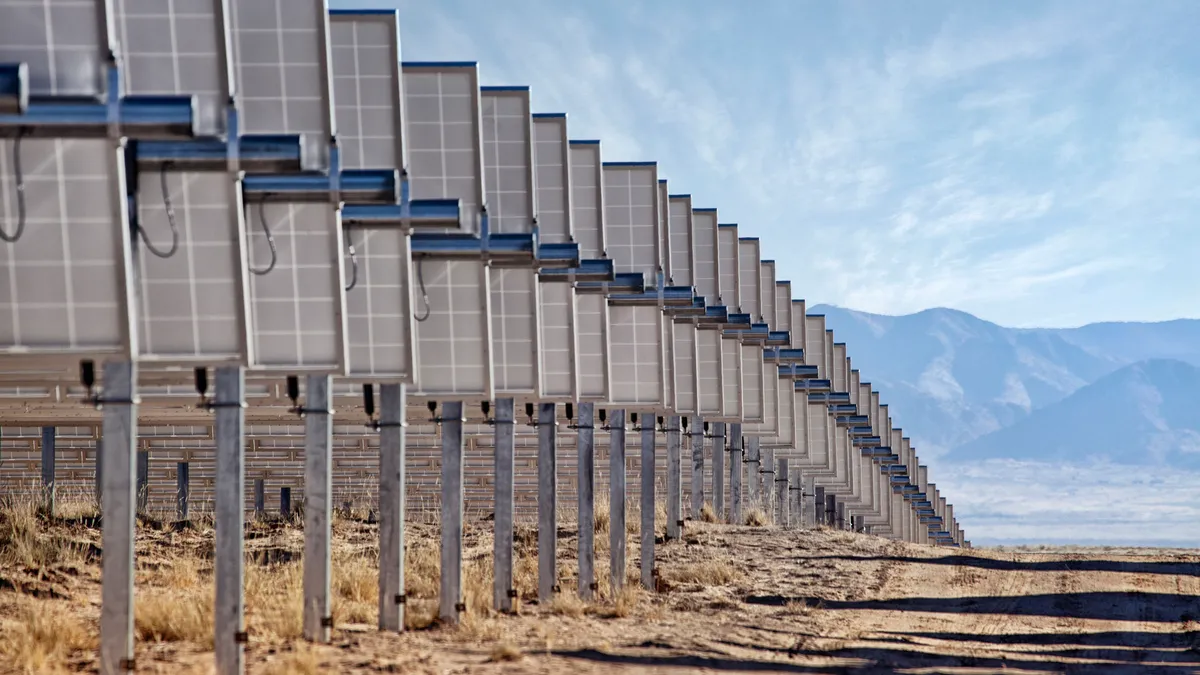UPDATE: May 12, 2020: The Department of Interior's Bureau of Land Management (BLM) approved the Gemini solar-plus-storage project on Monday. It is expected to be the eighth largest solar project in the world and could power up to 260,000 homes, according to BLM. The project is also expected to support up to 1,100 local jobs and inject $712.5 million into the economy.
"Our economic resurgence will rely on getting America back to work, and this project delivers on that objective," Interior Secretary David Bernhardt said in a statement.
Dive Brief:
-
The Trump administration intends to approve siting for the largest solar farm in the United States, a 690 MW facility that will also include 380 MW of 4 hour battery storage.
-
The Bureau of Land Management (BLM) released its final environmental impact statement for the project on Monday, following the Public Utilities Commission (PUC) of Nevada’s approval of NV Energy’s proposal Dec. 4. The $1 billion project will be sited on federal land outside Las Vegas.
-
Obama’s BLM had an agreement with conservation groups that protected sensitive desert land from wind and solar development that led to the rejection of some projects. The Trump administration indicated it would scrap that agreement in February 2018.
Dive Insight:
President Donald Trump has been generally critical of wind and solar, touting them as expensive, unreliable power sources. But the administration’s approval is indicative of the cost effectiveness of the resources even as the investment tax credit for solar winds down in 2020.
NV Energy’s Gemini solar-plus-storage project will cost around $38.44 per megawatt-hour under a 25-year contract and will take up approximately 7,100 acres of federal land, according to the utility. The project would mark the third time the Trump administration has approved solar siting on federal lands. In June 2018, BLM approved an 80 MW project in Wyoming and in November 2018, the bureau approved a 550 MW farm outside Joshua Tree National Park.
"The proposed Gemini Solar Project would represent a significant increase in renewable energy capacity for Nevada and the West," BLM Southern Nevada District Manager Tim Smith said in a statement announcing the bureau’s draft environmental review. "The BLM actively supports the Department of the Interior’s America First Energy Plan, an ‘all of the above’ strategy which supports energy development on public lands."
Conservation groups, including Basin and Range Watch, Defenders of Wildlife and the Wilderness Society cited concerns that the project may have "unavoidable impacts" to "sensitive resources" in public comments and blogs.
The Gemini project, if given final approval by BLM, would surpass a 579 MW solar farm in southern California that currently holds the record for the largest solar array in the United States.
Quinbrook Infrastructure Partners and Arevia Power are heading development of the project.
Nevada’s December approval of NV Energy’s integrated resource plan included 1,190 MW of solar and storage. In addition to the Gemini project, regulators approved a 200 MW solar with 75 MW battery with five hour duration storage project and a 300 MW solar with 135 MW of 4 hour battery storage facility. All three projects are expected to begin operation by Jan. 1, 2024.
BLM first opened up public comment on the Gemini project’s draft environmental impact plan in June and will close its final comment period Jan. 27.
Correction: The Obama Administration did not reject the Gemini solar project.














